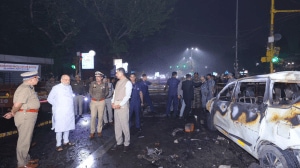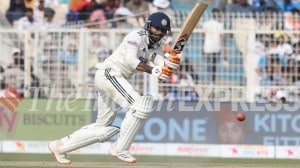Surviving Valley’s choppy waters, trout swims upstream
It is the feel good factor once again. Only, this time it is in unlikely Kashmir. And it has nothing to do with the recent peace attempts. F...

It is the feel good factor once again. Only, this time it is in unlikely Kashmir. And it has nothing to do with the recent peace attempts. For trout farming not only survived, but flourished, during the years of militancy to emerge as the Valley’s very own success story.
In 1984, when the J-K Fisheries Department started the pilot project in Kokernag Village in Anantnag, the target production was set at 10 tonnes. Today, the department’s 30 trout farms across the state have a total yield of 100 tonnes. With an initial investment of Rs 1.25 crore, the industry is now estimated at Rs 3 crore. And with trout being sold in the market at Rs 150 per kg, the department earns about Rs 40 lakh annually only through sale proceedings. And this is only the first phase of the project.
‘‘The trout has weathered years of uproar and rebellions. It has also survived the official lethargy when our staff and infrastructure were grounded,’’ said Showkat Ali, joint director of the Fisheries Department.
If the second phase is taken up immediately, Ali expects the production figure to touch 500 tonnes. However, at the moment, this second phase, which involves assistance and expertise from Norwegian and French governments including a Rs 18-crore grant, is caught in official wrangle. ‘‘If the project is cleared, trout production in the Valley will get a tremendous fillip,’’ said Ali.
The official believes the state will then even be able to export the trout back to Scotland, where it came from. It was the British who first introduced trout to Kashmiri waters. The first consignment of 10,000 trout eggs were sent from England in 1899. But they did not survive the journey. A year later, a new batch was sent from Scotland. That is why all the trout farms in the state today have Scottish variants in their waters.
‘‘Except for Jammu district, our trout farms have proliferated in all the districts — Ladakh, Kargil and even the border districts of Rajouri and Baramulla,’’ said Ali, who claimed to have registered 85-90 per cent success. In fact, out of the annual 100 tonnes produced, only 30 to 35 tonnes are sold. The rest are restocked and used for breeding.
So what makes Kashmir’s waters ideal for trout farming? ‘‘The waters are very rich in oxygen, providing the ideal conditions for the trout to multiply,’’ said Ghulam Jeelani, supervisor at the Dachigam farm where the authorities have set up a hatchery unit of Danish make. ‘‘The water temperature fluctuates between 4 to 24 degrees celsius. The trout breeds well in such climes,’’ he added.
Apart from the Rainbow Trout, primarily a table fish, the farms produce 3-5 lakhs of Brown Trout annually for angling as well as for the state’s tourism-oriented programmes. And to take the Rainbow Trout, once considered an elitist delicacy, to the common man, the department sells it at the subsidised rate of Rs 120 per kg at the district outlets on Saturdays.
Besides the domestic market, the Kashmiri trout could also be exported to Britain, Denmark and the rest of Europe if the second phase is cleared, said Ali. ‘‘We can satisfy our local market and also be in a position to export the surplus stocks to Europe,’’ he said.
The department plans to increase production by obtaining the latest feedmill that churns out five quintals of trout-feed in an hour. Four more feedmills are coming through French assistance to supplement the existing two.
Impressed with the fishing success, other States like Sikkim, Himachal Pradesh and Uttar Pradesh are now turning to J-K for expert assistance.





- 01
- 02
- 03
- 04
- 05


























